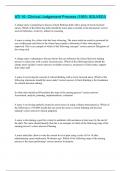Samenvatting
Summary Robot Interaction Lecture 1 + Literature
In this file, I have summarised both the live lecture 1 as well as the according to literature in a structured manner. It entails all the information required for both the assignments as well as the exam. It also includes a course description as well as the goals of the course. Since this is t...
[Meer zien]













